30 October 2023
![]() 10 mins Read
10 mins Read
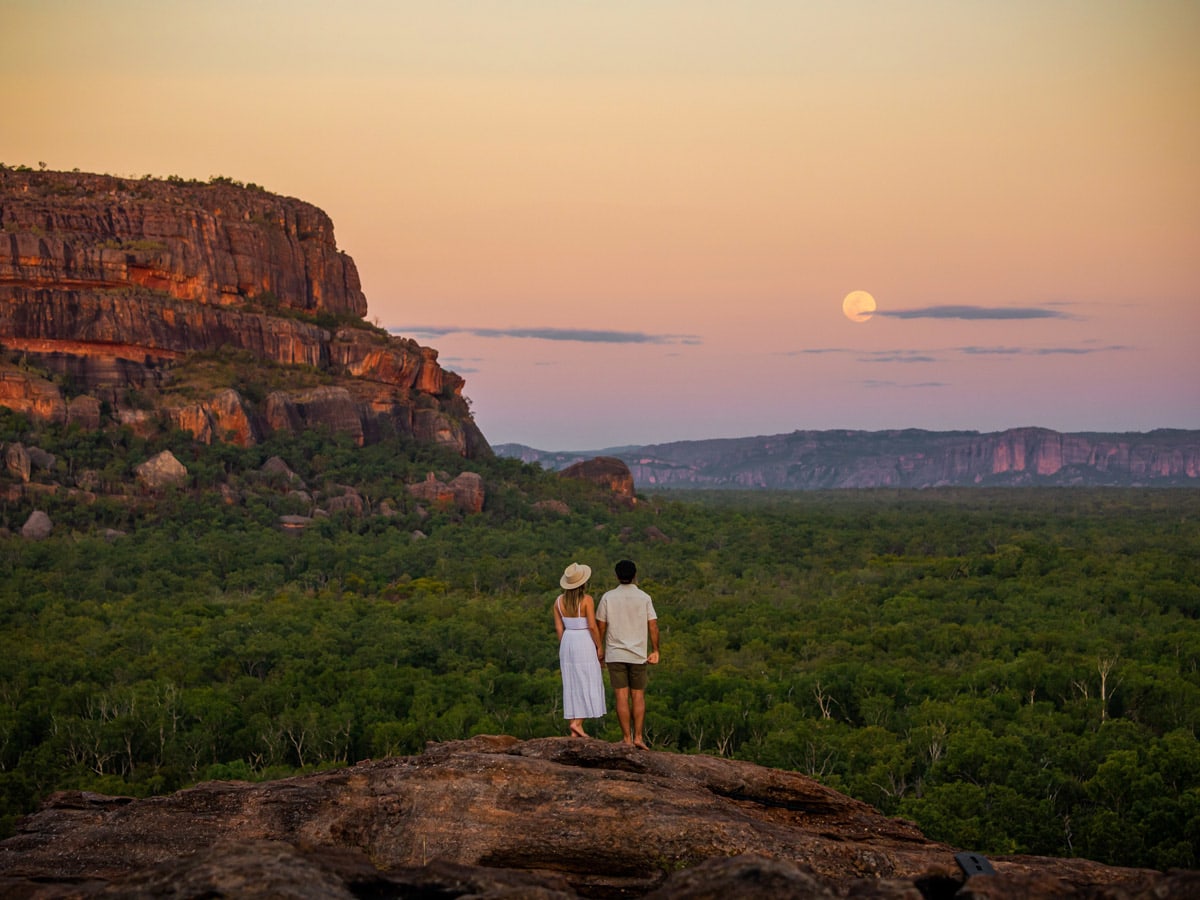
Kakadu National Park is nearly one-third of Tasmania in size. So, feeling bewildered when it comes to choosing the best things to do in Kakadu is understandable. The National Park is dual-listed by UNESCO as a World Heritage site for its cultural and natural attributes – meaning there’s plenty here to explore. Below, we’ve rounded up a guide on the best things to do in Kakadu whether you’re a foodie, nature lover or a history buff.
It’s worth noting that to enter, you’ll need to purchase a Kakadu National Parks Pass, which can be organised online, or bought at one of the locations listed on the Parks’ website. But once that’s sorted, check out our pick for the best things to do in Kakadu.
Best for: Families and wildlife lovers
The Yellow Water Billabong is Kakadu’s postcard shot: regular boats cruise across its great swathes of floodwaters, half-submerged paperbarks, pandanus and water lilies, while crocs cruise beneath. It’s no surprise this is one of Kakadu’s most popular things to see and do.
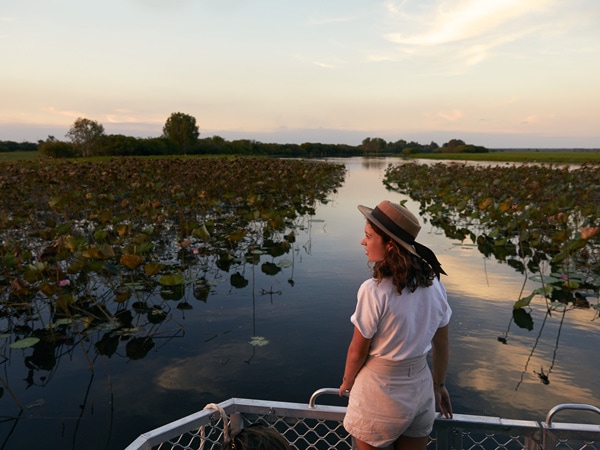
See waterlilies up close. (Image: Tourism NT/Matt Cherubino)
You can see many of Kakadu’s birds: jabiru, sea eagles, magpie geese and egrets. Cruises operate all year round; in the dry season, you can also explore the billabong on foot, via boardwalks.
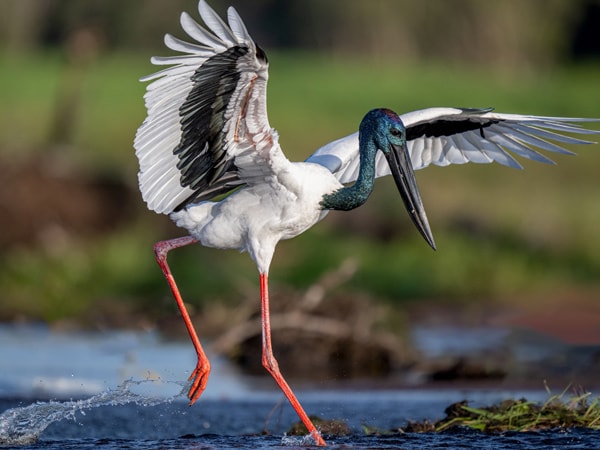
The impressive jabiru resides in Kakadu wetlands. (Image: NT/ Paul Thomsen)
If you’re after other cruises or tours in Kakadu, we’ve rounded up a guide to the best tours in Kakadu National Park.
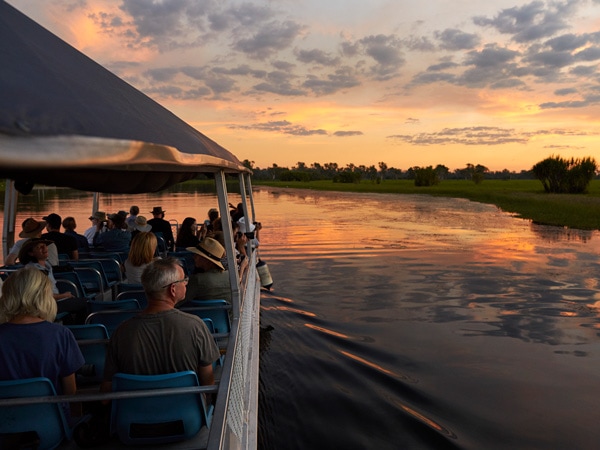
Soak up majestic sunset views during the Yellow Water Billabong Cruise. (Image: Tourism NT/Matt Cherubino)
Via 2WD in the dry (you can drive virtually up to the boat ramp); in the wet, you simply drive to the nearby hotel and hub Cooinda Lodge and hop on a shuttle bus.
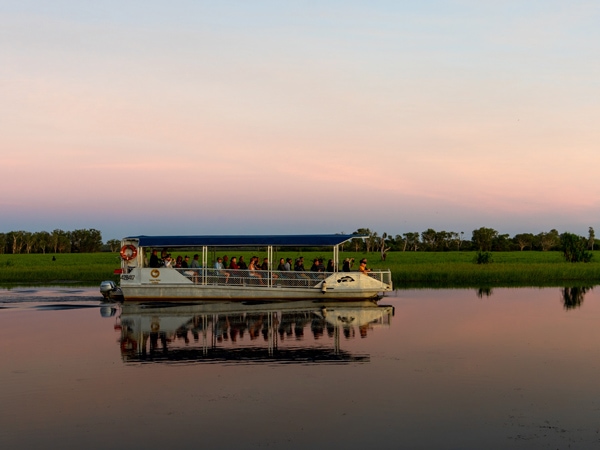
Hop on a Yellow Water Billabong cruise. (Image: Tourism NT/Bronte Stephens)
Best for: Travellers seeking serene vistas or photographers looking for a postcard-perfect shot
Nawurlandja lookout attracts locals, visitors and snap-happy photographers during golden hour, seeking the best vantage point to admire the surrounding rock formations as the escarpment starts to glow while the sun sets behind the vista.
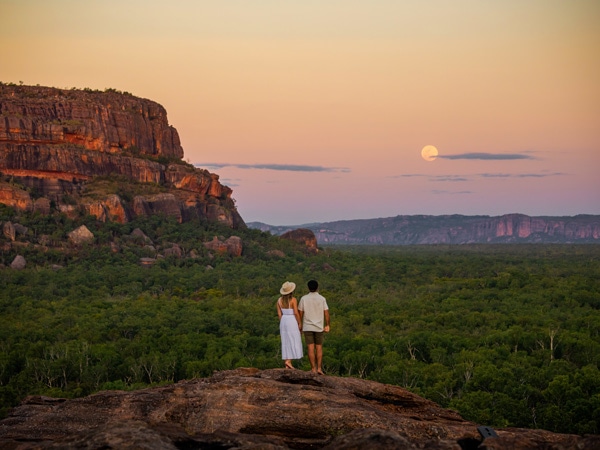
Take in breathtaking sights from Nawurlandja Lookout. (Image: Tourism NT/Kyle Hunter & Hayley Anderson)
Walk up the 300-metre incline for sweeping views over Anbangbang Billabong and towards Arnhem Land. Have your camera ready, this is one of the most picturesque spots in the park, especially when the sun starts to set.
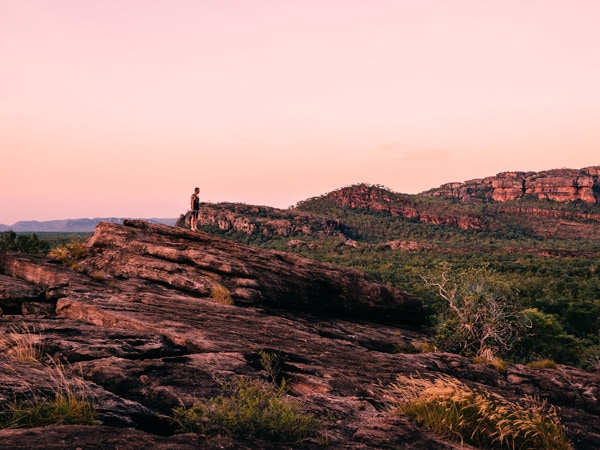
Hike up the rocky and rugged plains of Nawurlandja. (Image: Tourism NT/Jewels Lynch)
Best for: Active and adventurous traveller seeking off-the-beaten-path experiences
Of all the things to do in Kakadu, a swim at Maguk is one of the more under-the-radar activities, despite being absolutely stunning. It’s only an hour’s drive south of Cooinda Lodge (one of Kakadu’s popular accommodation options), but you’ll need to turn off the sealed highway and drive a 14-kilometre, 4WD-only track, then walk a kilometre to get here.
The effort required makes this one of the Park’s lesser-visited natural plunge pools, but it’s gorgeous to swim in, and the walk-in, via a beautiful creek and classic pandanus forest, is truly lovely. A short but steep climb will get you to the top of its waterfall, where more pools await you.
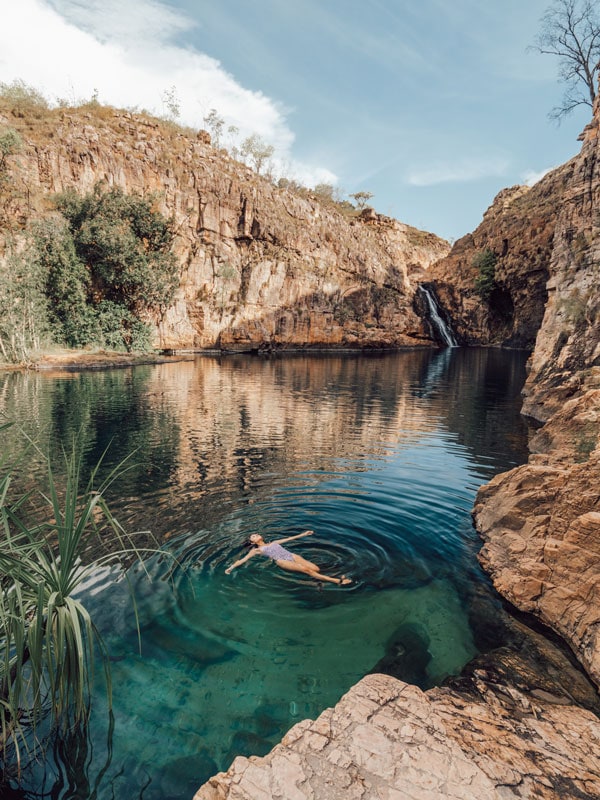
Relax on the refreshing waters of Barramundi Gorge (Maguk). (Image: Tourism NT/Adriana Alvarado)
Via 4WD in the dry; then it’s a two-kilometre, easy-to-moderate, return walk. Maguk is inaccessible in the wet.
Best For: Anyone curious about local culture
Ubirr is one of the most famous rock art sites in Kakadu. A kilometre-long circular walk from the car park takes in the Main Gallery, the Namarrgarn Sisters Gallery and the Rainbow Serpent Gallery, with the dates of art ranging from over 15,000 years old to as recent as 150 years ago.

Join a cultural walk tour to Ubirr. (Image: Tourism NT/Helen Orr)
A visit to Kakadu’s rock art is one of the most educational things to do if you’re interested in Indigenous culture. You’ll witness ‘X-ray’ style paintings of animals and figures from Dreamtime folklore.
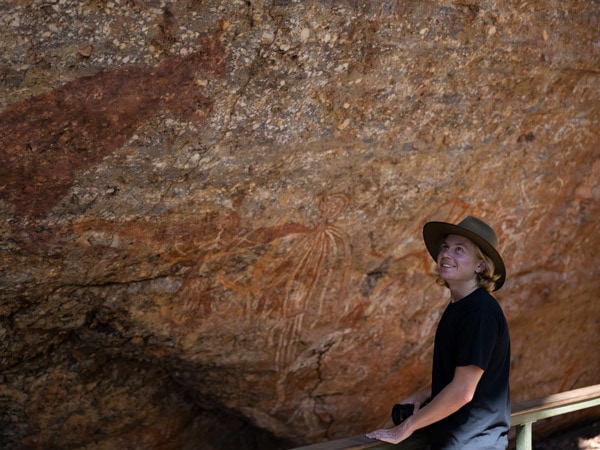
Learn about the Ubirr rock art in Kakadu. (Image: Tourism Australia)
Make sure you take the extra 30-minute moderate climb to Nardab Lookout for excellent sunset views.
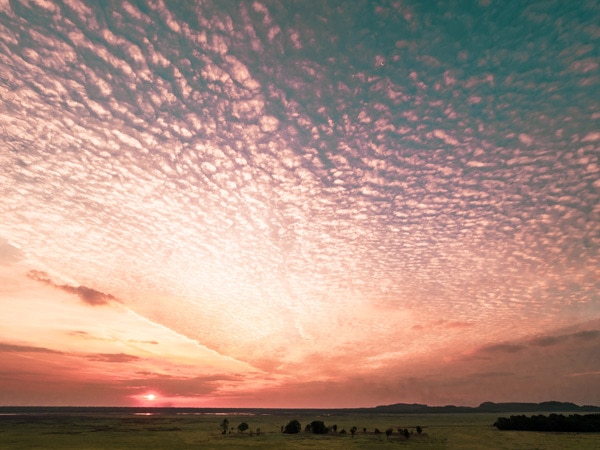
Pastel hues are majestically draped over the sky. (Image: Tourism NT/Jewels Lynch)
Via 2WD in the dry (though check road conditions early in the season). The circular track is partly wheelchair accessible. In the wet, only 4WDs can drive here; if 4WD access is also closed due to flooding, you might be lucky enough to access the site via boat, on a wet season Guluyambi Cultural Cruise.
Best for: Anyone curious about local culture
The second of Kakadu’s most famous rock art sites, the well-preserved area of Burrungkuy (Nourlangie) offers spectacular views and a fascinating window into local Aboriginal culture. You’ll need 90–120 minutes to tour the multiple art sites, along a 1.5-kilometre circular walk that also includes the Anbangbang Shelter, providing refuge from the weather for 20,000 years for locals who whiled away the time by decorating the walls with their stories.

Seeing the World Heritage-listed Nourlangie Rock Art up close is a powerful experience. (Image: Tourism NT/Shaana McNaught)
If you want to enrich your knowledge and experience of Kakadu’s rock art, Yibekka Rock Art Tours is a fantastic local offering. Their Indigenous guides lead tours to Burrungkuy, sharing the incredible stories behind the rock art and the Dreaming stories held within the landscape.

Nourlangie is one of Kakadu’s most famous rock art sites. (Image: Tourism Australia)
Via 2WD, year-round. The 1.5-kilometre walk is easy; the 600-metre climb to the lookout is moderately steep.
Best for: Travellers seeking a swim and some show-stopping scenery
No visit is complete without seeing Kakadu’s beautiful waterfalls – they’re key to the massive movement of water that marks the seasons. However close to each other geographically, they’re actually very different. Jim Jim Falls features vertiginous 150-metre-high cliffs surrounding a beautiful, deep plunge pool, and flows only after the wet season.
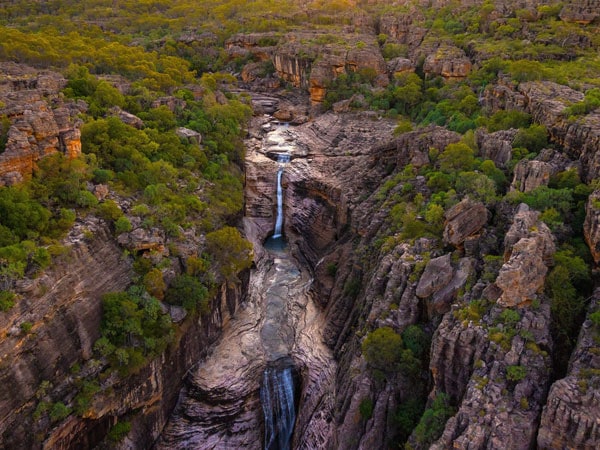
Jim Jim Falls looks stunning from above. (Image: Tourism Australia)
You can swim there in the top pool during the dry season and admire the unexpected presence of silica sand – this area was once an inland sea. Kakadu’s Twin Falls are in spectacular flow all year round, continuously gushing over a 220-metre drop onto the beach below.
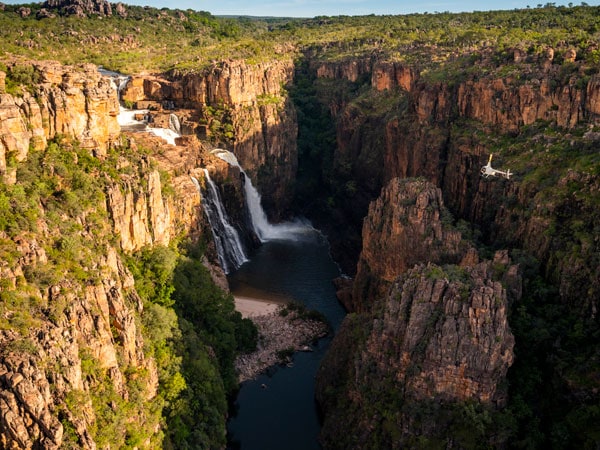
Appreciate the stunning beauty of Twin Falls. (Image: Tourism NT)
Twin Falls has a very pretty plunge pool, but you can’t swim here; saltwater crocodiles do occasionally make their home here. The plateau above it is safe for swimming, though, and well worth the hike up.
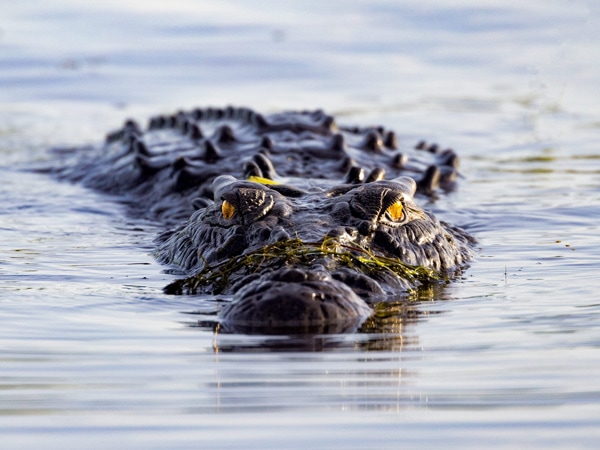
Spot saltwater crocodiles within Kakadu National Park. (Image: Tourism Australia)
You can get to Jim Jim Falls via 4WD in the dry season. From the car park, take a moderately difficult 45-minute walk over boulders to the top plunge pool where you can swim. To get to Twin Falls you’ll need a snorkel on your vehicle to get through a 0.8-metre water crossing. You then board a shuttle boat from the car park, which takes you up the gorge, before a short walk to the falls themselves.
Best for: Nature lovers and travellers looking to get active
The Yurmikmik walks are a series of interconnected trails exploring the wilds of the park’s southern region, and they are underutilised, underrated, local favourites. These trails are especially beautiful during the wet season, when the landscape becomes lush with greenery. You’ll also likely spot an abundance of wildlife, from wallaroos to cockatoos and finches.
The two-kilometre-return Boulder Creek Walk runs through monsoon forest and woodlands; the five-kilometre return walk to Yurmikmik Lookout takes you to the ridge for fantastic views over Yurmikmik country (pack your camera).
The 7.5-kilometre return Motor Car Falls Walk journeys along a historical track through to shady creeks and rainforest; and the ultimate Kakadu walking experience, is the 14-kilometre overnight Motor Car and Kurrundie Creek circuit, with some sections best navigated by GPS and compass (you’ll need a permit to camp here).
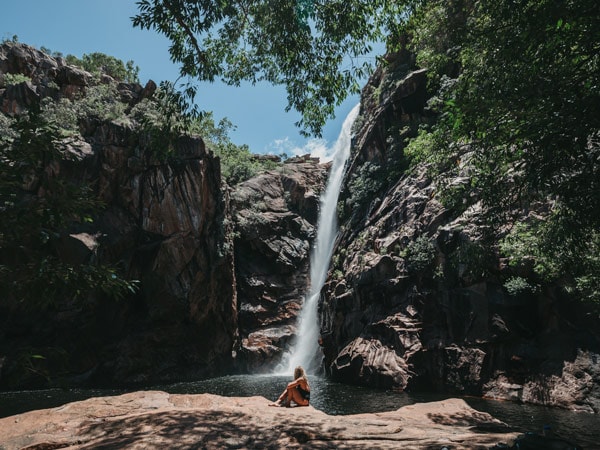
Take a refreshing dip at Motor Car Falls. (Image: Tourism NT/Jarrad Seng)
Via 4WD year-round. The area may be closed due to flooding in the wet.
Best for: Nature lovers and birdwatching enthusiasts
A hugely important part of Kakadu is its birdlife, and Mamukala has a bird hide shelter where you can have some quiet time and really enjoy the sight of thousands of magpie geese (particularly from September–October) coming together to feed, undisturbed.
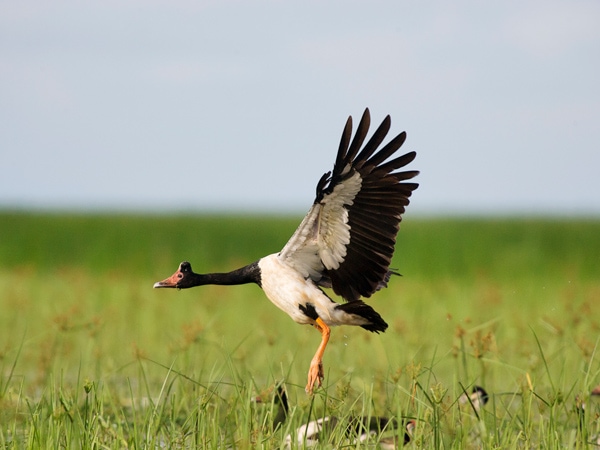
Visitors flick to Kakadu to admire the birdlife, including magpie geese. (Image: Bamurru Plains)
Take a self-guided tour on the nearby walks, ranging from one to four kilometres; the three-kilometre walk alongside the wetlands is ideal to enjoy the paperbarks, pandanus and water lilies. Beautiful and accessible for most of the year, it’s most dramatic in the late wet season when birds congregate in their thousands.
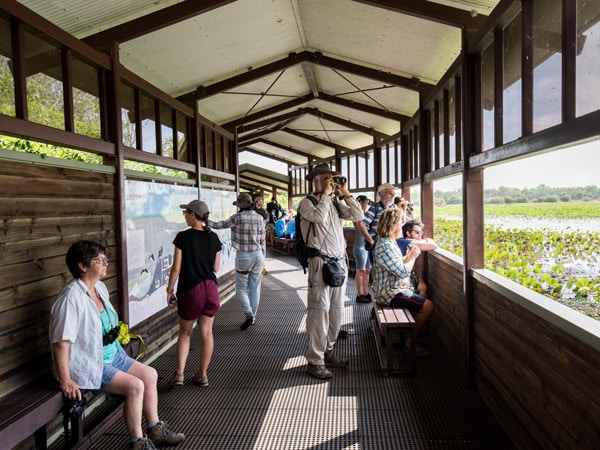
Birdwatchers gather at the Kakadu Bird Week. (Image: Tourism NT/Navin Chandr)
Via 2WD year-round, although the area may be closed due to flooding in the wet. The bird hide is accessible by wheelchair, 500-metre return; the three-kilometre loop walk is rated easy.
Best For: Foodies and culturally curious travellers
Did you know, there are six Indigenous seasons in Kakadu? Bininj chef Ben Tyler of Kakadu Kitchen is serving up a taste of each season with Kakadu Full Moon Feast.
The feast is an unmissable dining experience held six times per year, pulling together native and foraged ingredients where guests can experience the flavours of Country and culture. In addition, the meals are accompanied by non-alcoholic beverages made with unique bush ingredients like lime leaf and green ants.
Hosted at Cooinda Lodge, the Kakadu Full Moon Feast is a great way to learn about Bininj culture and indulge in an unforgettable night of food. For lovers of good food, this is one of the best things to do in Kakadu. If your stay aligns with the feast schedule, make sure you don’t miss out!
Best for: Anyone with an adventurous streak
If breathtaking scenery is what you’re after, then a scenic flight is one of the best things to do in Kakadu. Take to the skies for a bird’s eye view of the UNESCO World Heritage-listed Kakadu wetlands. Seeing Kakadu from a scenic helicopter – with the doors off – you’ll be treated to an unforgettable panorama.
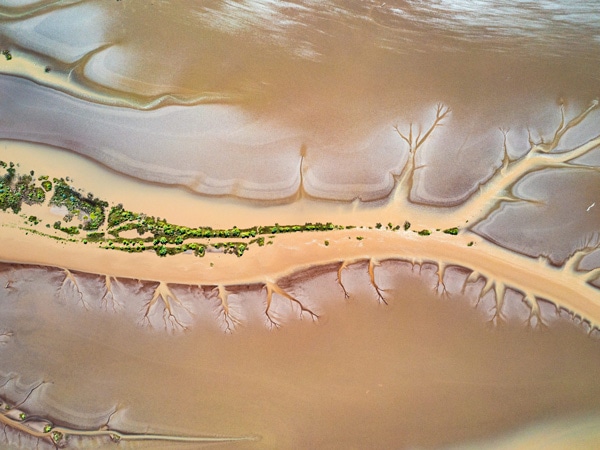
Venture across Kakadu on a helicopter. (Image: Tourism Australia)
Rise above verdant savannah woodlands, whizz past rocky escarpments and soar over exposed rocks that make up some of the world’s oldest. Watch magnificent waterfalls come into view, so close that you can almost feel the spray.
Kakadu Air Services are a local operator have scenic flights ranging from 20 minutes to an hour, and the Scenic Flight Company have flight options ranging from 30 minutes to 1 hr 45 minutes. A Kakadu scenic flight is the best way to witness the landscape and get your adrenaline pumping, too.
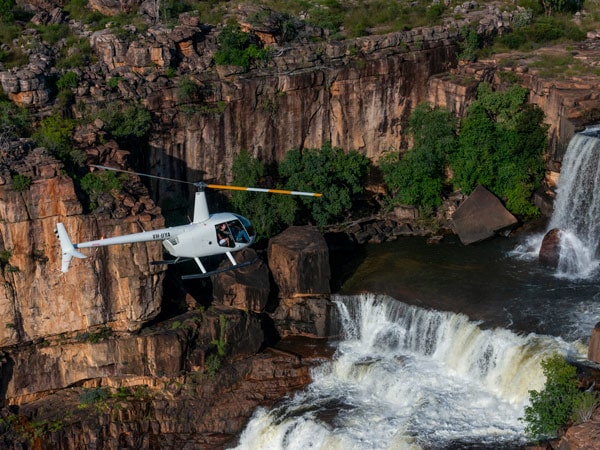
Take a scenic flight above Jim Jim Falls. (Image: Tourism NT)
Flights depart from the townships of Jabiru, Cooinda or Darwin.
Awesome info, thank you!!
I was there it is beautiful, even no more beautiful than in the photos